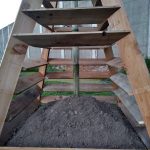FECO Water Conservation Grant – Step Three – Ollas and Perforated Pipe
March 19, 2018
Our efforts this year center on water conservation and we are attempting three different methods to deliver water to plants: gravity fed drip irrigation (coming soon), ollas, and deep perforated pipe. All of these methods will save water but they all will also minimize the time and physical effort it takes to water the plants.
Irrigating with ollas offers the following water conservation benefits:
- Less evaporation
- Less runoff
- Plant roots more directly targeted
- Less over-watering
- Promotion of deep roots
- More consistent soil moisture
Ollas (also referred to as pitcher irrigation) are used in nearly all parts of the world and have been in use for at least two thousand years. (Research by Siyal)
Ollas are often handmade. The clay pots are porous because they are unglazed. The release of water by the pot into the soil is very low tech! When the water content in the soil decreases due to absorption by the roots and/or evaporation into the air, more water passes from the pot into the soil. The dampness of the soil stays more or less constant at all times; a huge benefit for the health of many vegetable plants.
Potters can increase the porosity of the pot by adding other materials to the clay and also by firing the clay at temperatures below 1000 Celsius.
(Note: Using liquid fertilizers in the irrigation water may cause salt build-up and clog the small pores. Hard water can cause the same problem.)
Our pots originated in Mexico and are made with Tecate clay, found in an area 25 miles wide that stretches from the Northern Baja border South 60 miles.
We have finer soil at FECO so water dispersion might tend to be more horizontal than if you had sandy soil. We loosened the soil well when we installed the ollas to eliminate air pockets.
Olla irrigation is reported to be most efficient for crops with fibrous root systems like squash, melons, watermelons, tomatoes, and chilies.
Sun, May 20, 2-4, Work Party
Sat, Jun 2, 10-12, Work Party
Sun, Jun 17, 2-4, Work Party
We also buried perforated bamboo pipes around  the blueberries and up through the center of our new vertical garden.
the blueberries and up through the center of our new vertical garden.
We drilled a hole through each node but not through the bottom node. Then we drilled holes along one side of the pipe, for pipes buried next to a blueberry plant. Each bamboo pipe holds about 1/2 gallon of water. We buried the pipe vertical about two feet down and added a mesh screen at the opening to keep out debris.
Our hope is for the blueberry roots to reach down deep toward the water so the plant is more drought-tolerant in the summer. Perforated pipes are especially suitable for shrubs.
Our next challenge is the first part of the gravity fed drip irrigation system – the installation of 40 gallon reservoirs at each food bank garden bed.
Please consider joining us at the April work party or contact us if you can help on another date.
Ruth
David Bainbridge, in his book Gardening With Less Water (2015), and
http://www.globalbuckets.org/p/olla-irrigation-clay-pot-system.html


Wonderful work this Sunday!!!
Thanks for all your efforts.
Joan